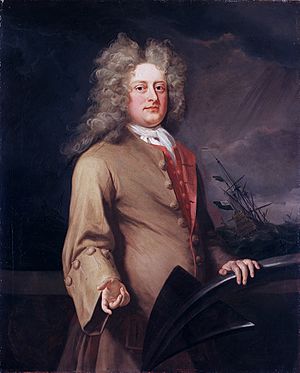Basil Beaumont facts for kids
Quick facts for kids
Basil Beaumont
|
|
|---|---|

Rear-Admiral Basil Beaumont (Michael Dahl)
|
|
| Born | 1669 |
| Died | 1703 |
| Nationality | British |
Basil Beaumont (1669–1703) was an important officer in the Royal Navy. He was known as a Rear-Admiral. Basil was the fifth son of Sir Henry Beaumont, 2nd Baronet. His family lived at Stoughton Grange and Cole Orton. He was one of twenty-one children!
Contents
Basil Beaumont joined the navy when he was quite young. His early time in the navy was quiet. But soon, he started to rise through the ranks.
Becoming a Captain
In 1688, at just 19 years old, Basil became a lieutenant on a ship called the Portsmouth. Just six months later, in 1689, he was made captain of HMS Centurion. Sadly, his ship was lost in a big storm in Plymouth Sound that same year. Even though he was a very young captain, no one blamed him for the loss.
After a few months, he was given command of HMS Dreadnought. Then, in 1692, he moved to HMS Rupert. On this ship, he took part in a major sea battle called the battle of Barfleur. He stayed on the Rupert for another year. In 1694, he commanded HMS Canterbury in the Mediterranean Sea.
Leading Squadrons
By 1696, Basil was commanding HMS Montague. This ship was part of a fleet sailing near the English Channel. For a short time, he was even put in charge of a smaller group of ships closer to shore. This role is called a commodore.
Later, he commanded other ships like HMS Neptune, HMS Essex, and HMS Duke. He was in charge of a group of ships near Dunkirk until peace was declared. In 1698, he took command of HMS Resolution. For a while, he was the most senior officer at Spithead. This meant he was in charge of many ships and could even hold special naval trials.
Promotion and Tragic End
Basil Beaumont kept working hard. In June 1702, he was moved to the Tilbury. He continued to command groups of ships in the North Sea. Finally, on March 1, 1703, he was promoted to Rear-Admiral. This was a big achievement! He was told to raise his admiral's flag on HMS Mary.
During that summer, he sailed in the North Sea. He also helped protect merchant ships traveling to the Baltic Sea. As winter approached, he returned to the Downs, a safe anchorage. On November 27, 1703, a terrible storm hit. It was known as the Great Storm of 1703. The storm pushed HMS Mary onto the Goodwin Sands. These are dangerous sandbanks in the sea. Sadly, everyone on board, including Rear-Admiral Beaumont, was lost.
Basil Beaumont's death made his name more famous than his naval career alone. He was a good officer. What's amazing is that he reached the rank of admiral when he was not yet 34 years old. He had only been in the navy for about fifteen years!
Family and Legacy
Basil Beaumont was not the only one in his family to serve in the navy. Two of his younger brothers also joined. Sadly, they both died before him. William Villiers, a lieutenant, died of a fever in the West Indies in 1697. Charles was lost when his ship, the Carlisle, exploded in 1700.
After Basil's death, his mother, Lady Beaumont, asked the Queen for help. She explained that her family needed support. Her request was successful. The Queen granted a yearly pension of £50 to each of Basil's six sisters.
Today, you can see a portrait of Basil Beaumont. It was painted by Michael Dahl. This painting is in the Painted Hall at Greenwich. King George IV gave it to the hall. It shows Basil as a handsome young man.

